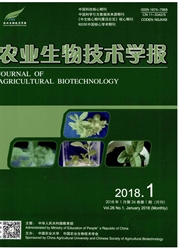

 中文摘要:
中文摘要:
哺乳动物胚胎体外培养体系影响着早期胚胎的发育潜能,在目前模拟体内输卵管及子宫的低氧环境的培养系统中,活性氧(reactive oxygen species,ROS)被认为是影响胚胎发育的一个重要因素。本实验探究了ROS在小鼠(Mus musculus)体外发育2细胞阻滞胚胎中对线粒体相关机能的影响。本研究使用2,2-偶氮二(2-甲基丙基咪)二盐酸盐(2,2’-Azobis(2-methylpropionamidine)dihydrochloride,AAPH)处理昆明白小鼠体外受精卵,通过荧光探针检测处理前后与线粒体活性相关的线粒体膜电位、线粒体ROS(mt ROS)及线粒体分布状态的变化,并利用q RT-PCR检测ROS相关基因、线粒体转录因子A(mitochondrial transcription factor A,TFAM)m RNA的表达量及mt DNA的拷贝数。研究结果显示,使用1.0 mmol/L浓度的AAPH分别处理的胚胎,具有较高的阻滞率(66.16%)和较低的损伤率(24 h畸形率9.09%,48 h死亡率10.39%),ROS染色实验结果显示,AAPH处理能够使胚胎内胞质ROS水平明显升高,所检测的ROS相关基因m RNA表达量升高。1.0 mmol/L处理后二细胞期胚胎线粒体膜电位及mt ROS水平明显高于对照组,mt DNA的拷贝数增加,q RT-PCR结果显示,处理组TFAM基因的表达量明显高于对照组。以上研究表明,AAPH处理引起的氧化应激反应及发育阻滞的胚胎中,线粒体活性升高,线粒体数目增加,线粒体转录因子A表达增强,表明线粒体参与调节细胞内ROS的动态平衡。本研究初步探究了ROS与线粒体相关功能变化的关系,为揭示卵母细胞成熟机制和优化哺乳动物胚胎体外培养体系提供了参考。
 英文摘要:
英文摘要:
In vitro culture system influences the development potential of mammalian early embryos. In the current culture systems, which simulating the hypoxic condition in vivo of uterus and fallopian tubes, the reactive oxygen species(ROS) is considered to be a major factor affecting embryo development. In this study,the effect of ROS on the mitochondrial function and the mitochondrial DNA(mt DNA) copy number in mice(Mus musculus) 2-cell embryos were studied. The fertilized eggs from the Kunming mouse were treated by 2,2’-azobis(2-methylpropionamidine) dihydrochloride(AAPH), then the mitochondrial activity, the mitochondrial membrane potential, the mitochondrial ROS(mt ROS) and the distribution of mitochondrial were observed by fluorescent detection, meanwhile, the expression of ROS-related genes, the mitochondrial transcription factorA(TFAM) and the mitochondrial DNA(mt DNA) copy number were detected by real-time PCR. The results showed that mouse embryos had a higher blocking rate(66.16%) and a lower embryo damage rate(24 h malformation rate of 9.09%, 48 h mortality 10.39%) in 1.0 mmol/L treated group. ROS staining results showed that embryonic cytoplasmic ROS levels were increased significantly after AAPH treatment, and the m RNA expression of ROS-related genes were also increased. After treated by 1.0 mmol/L AAPH, the membrane potential, the mt DNA copy number and the level of mitochondrial ROS(mt ROS) in 2-cell embryos were significantly higher than that of control group, and the expression of TFAM gene was also increased. The above results showed that the oxidative stress caused by AAPH resulted in embryo development block, the function of mitochondrial was promoted after treatment, with increased the mt DNA copy number and the expression of TFAM gene, which may participate in regulation of intracellular ROS dynamic balance in embryos. This study preliminarily explored the relationship between the ROS and the dynamic change of mitochondrial function, and might provide r
 同期刊论文项目
同期刊论文项目
 同项目期刊论文
同项目期刊论文
 期刊信息
期刊信息
